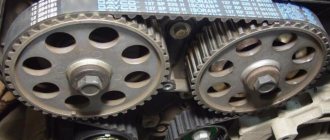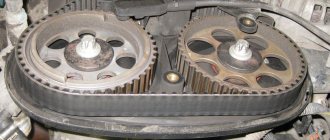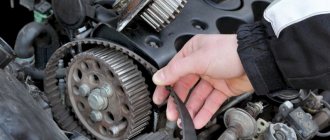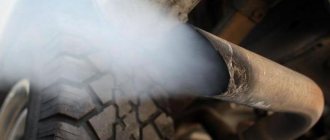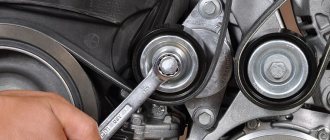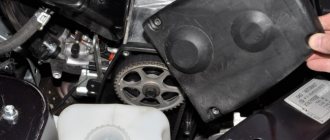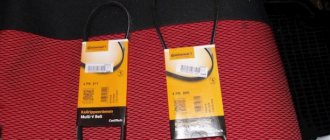The vehicle constantly requires proper care and constant maintenance of its main components. Often malfunctions in car operation are detected based on the sound that is characteristic of certain breakdowns. So, for example, it is easy to determine when the timing belt whistles.
This problem is considered serious for the vehicle as it can lead to critical consequences. A broken belt, as practice shows, can cause major repairs. But the whistle of the gas distribution mechanism is not always associated precisely with its failure. There are several reasons why you should not be afraid of the characteristic sounds of a belt.
Causes of alternator belt whistling
Many drivers refer to a poor-quality purchase of a belt, replace it and everything starts all over again, so before buying a new timing belt, it is better to diagnose the problem by conducting a thorough inspection of the belt drive and, if possible, eliminate it.
Analysis of the conditions under which a whistle usually appears comes down to the following steps:
- the degree of tension is examined (due to weak tension, a characteristic belt creaking often appears);
- the integrity of the entire belt is checked (there is an opinion among car owners that even new products are not always of adequate quality);
- the line of two pulleys is checked for their displacement;
- the cleanliness of the shaft is checked (one of the reasons for the “whistle”).
Methods for eliminating noise
The noise that appears immediately after starting the engine can be eliminated in several ways. All of them will be discussed in detail below.
Lubrication
As mentioned above, lubrication of the element, although not for long, eliminates the whistling and noise of the strap. This is the most popular solution to the problem if a whistle appears after installing a new belt.
The lubricant in this case is a special type of aerosol, sold in every store. In addition, the universal VD-40 is also suitable for these purposes.
Step-by-step instructions for lubrication:
- You need to open the hood of the car.
- Remove the protective cover secured with bolts.
- Start the engine.
Note. Lubricating the elements of the hydraulic lubrication mechanism on a running engine is much more effective than on a stationary internal combustion engine. Yes, this will require some skill, which boils down to the fact that you need to be able to aim accurately and get the liquid onto the inner parts of the strap.
- You need to lubricate for 5-10 seconds, so that this time is enough to process all the belt teeth.
- Then you need to turn off the engine, put the cover back in place and check for noise.
Leak and its elimination
The first reason for an oil leak lies in the cylinder head gasket. If it breaks through, it provokes timing belt noise. Surely, if oil or liquid gets on the belt, noise starts.
Five main causes of alternator belt whistling
- The condition of the car parts is one of the rules that is important for the vehicle owner to follow - cleanliness of the parts. One of the reasons for a whistling generator belt may be oil that accidentally gets on the belt or shaft. The reason is that the belt loses traction with the surface of the shaft, resulting in it slipping. Removing the belt and removing all traces of oil will most likely solve the problem.
- The cause of whistling may be weak tension and sagging. The solution is quite obvious - you need to look under the hood and check the degree of belt tension. If it is weak, the belt should be tightened.
- The timing belt also squeals due to the incorrect alignment of the pulleys. The pulleys must be strictly in one line, and even a slight slope often leads to squeaking or whistling. To fix the problem, you need to check the degree of displacement and align the pulleys correctly.
- A belt that is too tight can also lead to a characteristic “whistle”, since its rigidity does not allow the pulleys to rotate normally. This situation is quite often observed in the cool season - when the engine warms up, the timing belt regains its shape and the “whistle” disappears.
- A failed bearing often causes an unpleasant sound from the hanging belt. This problem can be solved by replacing it with a new bearing.
The listed reasons are the main and most common among vehicle owners. But there are also other reasons related to the operation of individual car mechanisms. The most important thing is to respond in a timely manner and take measures to eliminate problems.
GRS mechanism: operating principle
ATTENTION! A completely simple way to reduce fuel consumption has been found! Don't believe me? An auto mechanic with 15 years of experience also didn’t believe it until he tried it. And now he saves 35,000 rubles a year on gasoline! Read more"
Let's start with the basics. The GDS system stands out for its extremely complex structure. In order for it to periodically function in the correct mode, it is necessary to timely check and replace certain parts.
To understand why the noise appeared, we need to delve into the structure of the system in more detail.
So, the GDS mechanism is a device that ensures the admission of the fuel mixture into the cylinders of the power plant, and is also responsible for the subsequent elimination of gases.
Considered to be an extremely complex internal combustion engine device, the GDS mechanism is responsible for the proper functioning of the engine valves. Moreover, everything must be carried out strictly within certain periods of time. The functioning of the system must be combined with the operation of other mechanisms.
You can understand how the system works this way. For example, while driving, the driver presses the accelerator pedal to increase the speed of the car. As a result of this, the fuel mixture begins to flow into the internal combustion engine in larger quantities.
A motor is an even more complex device consisting of valves, actuators, shafts, etc. The task of the valves is to open and close in due time, and the drives are to create conditions for the automatic rotation of the shafts along the intended path and with a specific amplitude.
The camshaft pulley is located directly above the BC of the power plant. Valves and special pusher devices are also located here. Outside the cylinder head you can find the cam pulley disc.
Note. To prevent engine lubricant from being knocked out of the cover, the engineers provided a special oil seal.
It is important to understand that the new belt, which suddenly began to make noise, is put on the camshaft disc and receives its movement when the crankshaft flywheel rotates.
For good, or rather, correct belt tension, rollers are used. We must always monitor their normal functioning, just like the belt, they must be changed in a timely manner.
Timing belt whine when engine is cold
The question of why the alternator belt whistles when cold is of interest to many drivers, and the reason for this is its slipping.
In order to sufficiently spin the generator pulley, there must be a powerful torque from the crankshaft, and there are several reasons for this:
- The wrong lubricant was selected for the generator bearing. In cold weather, due to the significant compaction of its consistency, the generator pulley will not be able to rotate properly until the engine warms up and “unfreezes” the lubricant. Only then will the characteristic whistle stop. The solution to the problem may be to replace the lubricant with an option that is more resistant to low temperatures.
- The alternator belt is not tensioned enough. A similar situation - until the engine starts to work dynamically, a loose timing belt will not be able to “accelerate” to the desired speed on the pulley, it will slip and, as a result, an unpleasant sound will be heard.
Important! Please note that the timing belt can also whistle on a cold engine if there is a serious problem with the generator - this is a jammed pulley.
You can easily diagnose this problem yourself; to do this, you need to try turning the generator pulley. If it does not spin, serious repairs or replacement of the generator will be required.
Step-by-step instructions for eliminating the defect
If noise appears when starting the engine after replacing an element, then there are several ways to eliminate the problem. Each of them will be considered in turn. If the quality of the strap is too low and it is already worn out, then it will need to be replaced; there are no other options. We will not consider this process, since it is individual for each car.
Use the search on our website to find step-by-step instructions for replacing an element for your car. You will find more information about this here. Next, we will look at options for eliminating the problem without removing the strap.
Lubricating the strap
Lubricating the element is one of the solutions to the problem if, after replacing the component, noise appears when starting the engine.
To lubricate the component, you need to purchase a special aerosol, which is sold in any store. In addition, universal WD-40 can be used for these purposes. Naturally, this solution is temporary, but it will only take a few minutes, after which the noise will no longer bother you.
Lubricated tension roller
- Take your aerosol and open the hood of your car.
- Remove the protective cover of the mechanism, which is secured with bolts, using the appropriate wrench.
- Be careful as you will need to start the car for it to work. This will make lubrication more effective. After starting the engine, you will need to aim to ensure that the liquid hits the inner parts of the strap, that is, the teeth. Lubricate the element for five to ten seconds so that the liquid is guaranteed to reach all the teeth.
- Stop the engine and replace the mechanism cover. Enjoy the results.
Belt whistling in rainy and wet weather
Operating a car in conditions of high humidity is often accompanied by a characteristic “whistle”. Moisture, for obvious reasons, gets on the surface of the belt, thereby reducing the frictional ability of the material, and also affects the pulleys. Such sounds are short-term in nature, and this only indicates that the belt has begun to lose elasticity and, if wear allows, it should be tightened.
In humid, damp weather, the frictional abilities of the belt material are significantly reduced. A slipping belt means there is a problem with the belt drive, and wet weather, rain or splashing is simply an indicator that it may need to be replaced soon.
Friction is important
The essence of mechanical defects is familiar to experienced amateurs and professionals. Let it be a sound, vibration or whistle, but they always differ from standard noise and attract attention.
The piercing whistle emitted by a faulty timing belt is unlikely to be confused with anything else. And rest assured that if it whistles, not only you and the people sitting in the cabin will hear it, but also those around you.
Note. The statement that says: the whistling of the belt clearly indicates wear of the part is not entirely true. This is wrong. Or rather, only partly.
The nature of a given sound may be on a completely different plane. Before judging why a part whistles, it is recommended that you familiarize yourself with the design of the unit, understand its operation, and only then draw the appropriate conclusions.
But it is clear that the cause of the whistling of a V-belt drive is always friction. And the details don't matter at all. If a whistle occurs, it means that the interacting surfaces, or one of them, have lost their original properties.
Howling belt under the hood
Belts, like bearings and shaft rollers, are always influenced by a large number of third-party factors. These include atmospheric humidity, wear due to temporary reasons, mechanical stress, insufficient or complete absence of lubrication, and much more.
Consequences associated with belt whistling
A problem related to the alternator belt that is not resolved in a timely manner can subsequently hit the car owner’s budget.
- The first thing that can happen is chronic undercharging of the battery. This will lead to a complete lack of charge and failure of the battery.
- A whistling sound may indicate complete wear of the belt and the possibility of its breakage. If this situation happens outside the countryside, you are unlikely to be able to drive a car.
When the whistle begins to appear, it is best not to tighten the situation and diagnose the tension and general condition of the belt.
Important! If the alternator belt breaks, the engine stops cooling. It is prohibited to drive such a car! Otherwise, the engine will overheat with very dire consequences.
Understanding the device
To understand why the timing belt whistles after replacing it or after a long period of use, when starting the engine or simply when it is running, you need to understand the device. The issue of noise is pressing for many domestic motorists.
Removing the timing belt
The timing belt is a device that ensures the admission of the combustible mixture into the engine cylinders and the further removal of exhaust gases from the combustion chamber. This mechanism, as mentioned above, is one of the most complex motor devices, since it must not only open and close the valves. The timing belt must be done in a specially designated period of time. In any case, the operation of the unit must be synchronized with the functioning of the ignition and injection system.
When the driver needs to increase the speed, he presses the gas pedal, thus ensuring that more gasoline and fuel mixture enters the engine. This device consists of several groups of parts. Engine valves are designed to open and close intake and exhaust ports. The engine drives ensure rotation of the shafts at a specific speed. And the purpose of the distribution pulleys is to control the valves.
A head is installed above the cylinder block of the internal combustion engine, on which you can see the distribution pulley, valves and pusher devices. The timing pulley disk is located outside the cylinder head. To prevent engine fluid from leaking out from under the valve cover, a special oil seal is installed on the camshaft. The timing belt, which suddenly whistles after replacement, is put on the camshaft pulley disk and begins to function when the crank pulley gears rotate.
What to do if your belt whistles
If the above reasons for the whistling of the generator belt could not be eliminated and it has not stopped whistling, while it has good tension, the pulleys rotate smoothly and evenly, it is intact and clean, then the problem may be the following: poor quality of the belt itself or in the equipment driving it drives: a generator, tension rollers, an air conditioning compressor, a power steering pump, etc. It is also possible that the grease has simply thickened in the bearings or they have failed.
You can try to temporarily eliminate timing belt whistling using special auto chemicals. Automotive stores offer many products for the prevention and protection of alternator belts. It is recommended to lubricate the alternator belt with conditioner-tensioner to prevent it from whistling to increase its elasticity and prevent cracking. In many cases related specifically to tension or increased wear of the belt, such means can completely get rid of the whistle.
Manufacturers of these fluids recommend applying these products for preventive purposes even before the whistle appears, then the service life of the alternator belt will significantly increase.
Consequences for the car
If you ignore the whistle and continue to drive with a worn timing belt or a skewed tensioner, you may encounter a drive failure. This will create a desynchronization in the movement of the piston system and the cylinder head valve mechanism. They will begin to converge and disperse chaotically. The internal combustion engine will definitely stall and it will be impossible to start it. You will have to tow the car to the service station, calling a friend on wheels or a taxi.
Bend valves
But that is not all. In some engine models, this means that the pistons and valves will literally meet. Since the connecting rods are more powerful, the valve stems bend during a collision. The nickels themselves may break off and parts of them will fall into the cylinders. For repairs, you will need to completely remove the cylinder head, oil pan, crankshaft, connecting rods and check each cylinder for metal debris. Then buy new valves and restore the broken seats in the block head. To do this, they are welded with argon, then sharpened and ground. Therefore, you should not ignore the whistle and it is better to immediately contact the service.
Video “The easiest way to tension a belt”
You can learn about the easiest and simplest method of tightening a strap from this video.
The timing belt is a generator belt in the form of a rubber band with notches on the inside that connects the crankshaft and camshaft of the engine and synchronizes their operation. It usually operates silently, but sometimes its whistle can be heard when the engine starts. This sound is heard by everyone around and causes discomfort. The cause of the noise is not only its wear and tear, but also a number of other factors, which we will discuss below.

